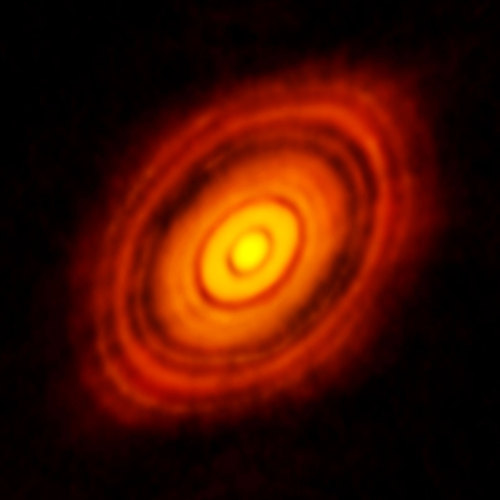
Capturing the Birth of Planets
You know what’s neat about this image? It isn’t an artist’s impression—it’s a real image that shows, in unprecedented detail, the disc of gas and dust spinning around a young star.
Stars form when cloudy regions of hydrogen and helium begin to gravitationally contract. As pressure increases, so does temperature, until the core of the cloud is hot enough to for fusion to take place and stars to ignite. The leftover matter flattens into a spinning disc, and eventually, the particles in this disc accumulate to form asteroids, comets, and planets.
Most of what we know about the formation of star systems is just theory, but this image above provides evidence of a new star and its protoplanetary disk. It was taken by ALMA (the Atacama Large Millimeter/submillimeter Array) in Chile, and is extraordinarily sharp because it was captured at wavelengths smaller than a millimetre. The young star at the centre is called HL Tauri, which is 450 light years from Earth in the direction of the constellation of Taurus. HL Tauri can’t be seen at all at visible wavelengths because it’s hidden behind a cloak of gas and dust, but since ALMA makes observations in the infra red, HL Tauri is visible to it.
It’s a big step forward in observing how stars and their planets develop. What’s especially interesting is the way the disc has already separated into concentric rings with distinct gaps between them.
“These features are almost certainly the result of young planet-like bodies that are being formed in the disc,” says Stuartt Corder, ALMA Deputy Director. “This is surprising since such young stars are not expected to have large planetary bodies capable of producing the structures we see in this image.”
HL Tauri is only one million years old—an infant compared to the vast lifespan of a star—which suggests that planets may form much quicker than we’d previously thought. Researchers are not yet sure whether this is the case for all stars, and what it will mean for planetary-formation throughout the galaxy and the universe.
This beautifully sharp evidence of planetary formation has only opened up more questions. As we take more images of this system and others, our understanding of this process will hopefully grow, and we’ll come to understand the formation of our own solar system.
Nenhum comentário:
Postar um comentário